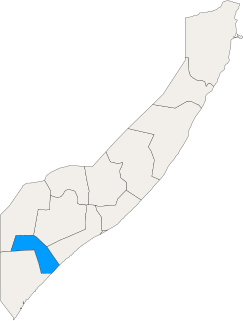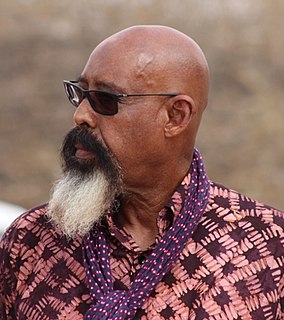Related Research Articles

Middle Juba is an administrative region (gobol) in southern Somalia. With its capital at Bu'aale, it is located in the autonomous Jubaland region.

Kismayo is a port city in the southern Lower Juba province of Somalia. It is the commercial capital of the autonomous Jubaland region.

Afmadow is a city in southern Somalia, located in the middle of the Juba region and bordered by Kenya, Badhadhe, Kismayo, Jamame, Jilib, Hagar, Bardhere and Elwaq in Somalia, 401 km southwest of the capital Mogadishu. It is home to a wide variety of wild animals, including the Big Five game. The vegetation in Afmadow consists of rich grassland, bounded by semi-desert. It is located northwest of Kismayo. Distance between Afmadow and Kismayo is 110 kilometers or 68 miles.
Barre Adan Shire, also known as Barre Hiiraale, Barre "Hirale" Aden Shire, or Abdikadir Adan Shire, is a former Minister of Defense of the Somali Transitional Federal Government (TFG). He was previously the TFG Minister for National Reconstruction and Resettlement. Hiiraale was also the Chairman of the now defunct Juba Valley Alliance, which controlled Southern and Southwestern Somalia, including the nation's third-largest city, the strategic port town of Kismayo. During his time in office, Hiiraale presided over the country's largest autonomous area, as well as commanding an extensive militia.

The Somalia War, also known as the Ethiopian invasion and occupation of Somalia, was an armed conflict involving Ethiopian (ENDF), Transitional Federal Government forces and Somali troops from Puntland, against Islamist militias for control of Somalia.
The Somali Patriotic Movement is a political party and paramilitary organization in Somalia, and a key faction in the Somali Civil War. Commanded originally Ahmed Omar Jess then by Aden Abdullahi Nur Gabyow, it was based in the southwestern area of the country, and had considerable influence in the leaderless country.
Following the civil war and the ensuing societal chaos, some factions managed to exert a degree of authority over certain regions of Somalia where they maintained broad, clan-based support. This allowed these factions to establish working administrations and eventually coherent states, and restored order to their regions. This occurred first in Puntland, Southwestern Somalia, Galmudug, Jubaland and finally Banadir.
The Fall of Mogadishu occurred on December 28, 2006, when the Islamic Courts Union peacefully withdrew from Mogadishu. The army of Somalia's Transitional Federal Government (TFG) and Ethiopian troops entered the Somali capital unopposed. The Ethiopian Invasion of Somalia continued until 2009.
The Somalia Reconciliation and Restoration Council (SRRC) was a political movement and paramilitary organization based in southern Somalia. It was founded in 2001 by Hussein Mohamed Farrah Aidid, son of the late faction leader Mohamed Farrah Aidid. Growing out of the Somali National Alliance (SNA) led by Aidid, the SRRC was originally formed to oppose the nascent Transitional National Government (TNG) and the Juba Valley Alliance (JVA) in the 2001-2004 period. However, it eventually settled differences with the government and some moderate leaders were incorporated into the new interim administration.

The transitional federal government (TFG) was the government of Somalia between 2004 and 2012. Established 2004 in Djibouti through various international conferences, it was an attempt to restore national institutions to the country after the 1991 collapse of the Siad Barre government and the ensuing Somali Civil War.

The Battle of Jilib was a battle in the 2006 Somali War fought by the Islamic Courts Union (ICU) and affiliated militias against Ethiopian and Transitional Federal Government (TFG) forces for control of the town of Jilib. It began on 31 December 2006, when ICU forces dug in and defended the town to prevent approach to Kismayo, the last stronghold of the ICU.
After two decades of violence and civil war and after the Transitional Federal Government (TFG) of Somalia captured Mogadishu and Kismayo, the TFG attempted to disarm the militias of the country in late 2006. According to the UN/World Bank's Joint Needs Assessment (JNA) coordination secretariat, "the total estimated number of militias [militia members] to be demobilized is 53,000." In 2005, they estimated that "there are 11-15,000 militia people controlling Mogadishu ."

Mohammed Said Hersi Morgan, also known as General Morgan or Colonel Morgan, is a Somali military and faction leader. He was the son-in-law of Siad Barre and Minister of Defence of Somalia. His military campaign in Southern Somalia in 1992 was one of the main causes of the famine in Somalia. He hails from the Mejerteen Darood clan.
Colonel Abdulahi Sheik Ismael (Fara-Tag) is a commander in the army of the Transitional Federal Government (TFG) of the Republic of Somalia.
Sheikh Hassan Abdullah Hersi al-Turki was a Somali Islamist leader of al-Itihaad al-Islamiya (AIAI) and later of the Islamic Courts Union (ICU).
Over the course of the Somali Civil War, there have been many revolutionary movements and militia groups run by competing rebel leaders which have held de facto control over vast areas within Somalia
The Allied Somali Forces (ASF) was a political faction of the Somali Civil War. It was the primary opponent of the Somali Patriotic Movement (SPM) vying for the control of Kismayo and the Juba River valley, the area known as Jubaland.
The timeline of events in the War in Somalia during 2006 is set out below.

Operation Linda Nchi was an operation where the Kenya Defence Forces entered southern Somalia beginning in 2011. The Kenyan government declared the operation completed in March 2012, but its forces then joined AMISOM in Somalia.

Jubaland, the Juba Valley or Azania, is a Federal Member State in southern Somalia. Its eastern border lies 40–60 km (25–35 mi) east of the Jubba River, stretching from Gedo to the Indian Ocean, while its western side flanks the North Eastern Province in Kenya, which was carved out of Jubaland during the colonial period.
References
- ↑ "Somalia: Main Political Organizations". Mudug.com. Archived from the original on 2006-09-27. Retrieved 2007-01-03.
- ↑ Footnotes to History: G to J Archived 2016-03-03 at the Wayback Machine Footnotes to History
- ↑ Somalia Assessment, September 1999 Country Information and Policy Unit, Immigration & Nationality Directorate, Home Office, UK
- ↑ "Somalia". World Statesmen. Retrieved March 9, 2006. – also shows Italian colonial flag & links to map
- ↑ Report of the Secretary-General on the situation in Somalia, 11 Oct 2001, Document S/2001/963 United Nations Security Council
- ↑ Simultaneous Heavy Fightings Erupt in Somalia People's Daily
- ↑ Recurrent displacements in southern and central Somalia due to intermittent inter-factional conflicts (2004) Archived 2012-07-20 at the Wayback Machine IDMC
- ↑ SOMALIA Land Mine Monitor
- ↑ Somalia's Islamists Resume Their Momentum and Embark on a Diplomatic Path Archived 2009-04-22 at the Wayback Machine PINR
- ↑ Witnesses: Somali Islamists advance on key port Archived 2015-02-13 at the Wayback Machine . Associated Press , 13 September 2006
- ↑ War Clouds Loom over Somalia as Military Fronts Open Up Amid a Flurry of Diplomacy Archived 2009-04-22 at the Wayback Machine PINR
- ↑ Somalia: Islamic militants advancing to Kismayo Archived 2011-08-09 at the Wayback Machine SomaliNet
- ↑ Somalia: Islamists shooting kills people in Kismayo protest Archived 2011-08-09 at the Wayback Machine SomaliNet
- ↑ Somalia’s Islamic Courts attain Afmadow in Lower Jubba region Archived 2007-09-27 at the Wayback Machine Shabelle Media Network
- ↑ Somali Islamists seize strategic post Archived 2006-12-02 at the Wayback Machine Al Jezeera
- ↑ Islamists seize a new settlement in southern Somalia Archived 2007-09-27 at the Wayback Machine Shabelle Media Networks
- ↑ Somalia: Insecurity rages in Islamist abandoned areas Archived 2007-09-30 at the Wayback Machine Shabelle Media Network
- ↑ Somalia: Situation Report – 27 Dec 2006 OCHA
- ↑ "Somalia at a critical crossroads". Hiiraan. Retrieved 21 November 2015.